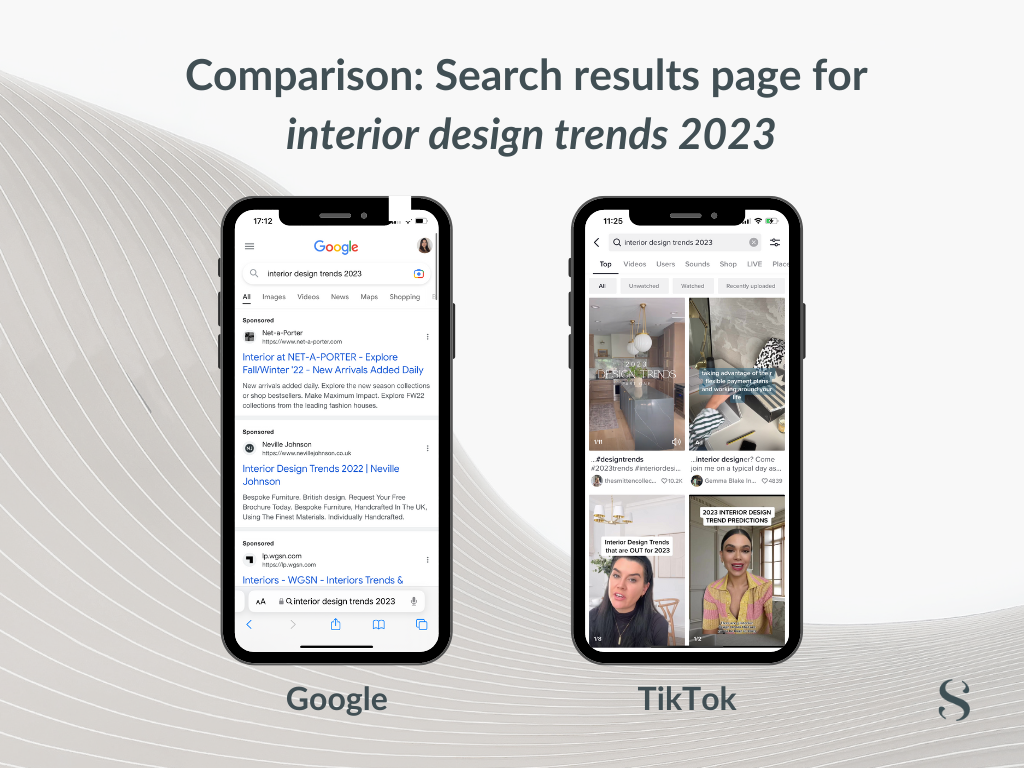TikTok vs Google
Can this popular video platform rival one of the world’s largest search engines?
Owned by the Chinese company Bytedance, TikTok started as a social media platform where younger generations came together to share their dance videos using trending music. With 672m downloads across the globe in 2022, TikTok has proved to be the new platform of interest for many brands and an intriguing opponent for Google.
The growing rivalry between TikTok and Google
Ever since Instagram introduced short videos (Reels), many marketers reflected on the fact that Instagram was turning into TikTok. This was also followed by the much-criticised shift in the Instagram algorithm in 2022 that was suggesting 'relevant' video content (Reels) from accounts we didn't follow rather than images shared by the accounts we deliberately followed. Even Kylie Jenner posted ‘Make Instagram Instagram again.(stop trying to be tiktok i just want to see cute photos of my friends.) Sincerely, everyone’ in summer 2022.
Even though some might think this was the main battle, the actual war has been happening somewhere else. It is Google, one of the most powerful tech giants, that has been challenged by TikTok in the past year. Mavrck’s influencer marketing predictions for 2023 are one of many to note the increasing competition between TikTok and Google when it comes to the search engine. And the people to ‘blame’ here are Gen Z.
Gen Z introduces a cultural shift
Who is Gen Z, and why are they so widely discussed? Dictionaries describe Gen Z as ‘a generation of people born between 1997 and 2012’. You might have noticed how the social and cultural practices of this generation have been defining the economic and digital spheres for a few years, and this is just the beginning. And since the introduction of TikTok to the market, the internet has been calling them ‘the TikTok generation.’
Prabhakar Raghavan, Senior VP at Google, acknowledged that the use of core Google services such as Search and Maps is being heavily impacted by the growing preference for social media and video content that are popular amongst younger users. He also noted that how they search is also different: Gen Z doesn’t use keywords but rather looks to explore content in more immersive ways. The short-form video format perfectly suits the younger generation because it is visually engaging and easier to digest than Google’s Search Result page, which is mostly populated by text (website links and descriptions). Raghavan also admitted that ‘almost 40% of young people, when they’re looking for a place for lunch, don't go to Google Maps or Search,’ he continued. ‘They go to TikTok or Instagram.’
To translate Raghavan’s example to the design industry, we have entered the search terms ‘interior design trends 2023’ in both Google and TikTok to illustrate the difference of the search results. The difference is striking: TikTok’s results page is more engaging visually than Google’s list of websites, some of which are sponsored. As the design industry is very visually-led, it is more sensible for the user to watch an engaging video than read a lengthy article, even though the latter includes images. An advantage of TikTok is that users can instantly get a sense of the creator in real time by investigating the account and understanding if they align with their tastes and values.
TikTok was propelled onto the social media scene with viral dance content that first appealed to Gen Z, but its increasing popularity has been attracting other age groups and more sectors, such as fashion, beauty, design, real estate, and more.
The important factor to consider is the relevance of the search. TikTok’s algorithm has been serving the audience content based on their previous interactions on the app. So if you have searched and watched interior design and architecture-related content, TikTok’s algorithm will populate your FYP (For You Page - the equivalent of Instagram’s main feed) with content related to interior design and architecture. Another differentiating factor between TikTok and Google is the way content is consumed.
Google is fighting back
Are we progressively reaching towards a different way of discovering content and learning new information? As reported by TechCrunch, Google announced a series of new features that will enhance the search experience. These include ‘making such a more visual experience, highlighting maps snippets, imagery and even video in new ways.’
Image credits: Google via TechCrunch
Interestingly, TikTok isn’t perfect either. The New York Times noted that ‘TikTok has leaned into becoming a venue for finding information,’ but the early findings show that TikTok, like other social media platforms, needs to improve when it comes to sharing misleading content. The New York Times further suggests that a practice of fact-checking needs to be implemented by all users. And this fact-checking is happening nowhere else other than Google… After all, a simple Google search won’t disappear but the way we use it will change with time.
As digital marketers, we continue to monitor how design brands are using TikTok and consider ways that it can enhance your brand profile. However, just like Instagram, the demand for creativity with short-form video content is still something many brands find cost and time heavy.
Google continues to offer a richer search experience overall with insightful analytics to help you understand search intent amongst other things but challenging both tech giants to respond to the changing way we search can only be a good thing in the long-term for all generations.
If you are looking for a team that will look holistically at your communications strategy and help kickstart your digital journey, then get in touch. We’d love to help tell your story.





